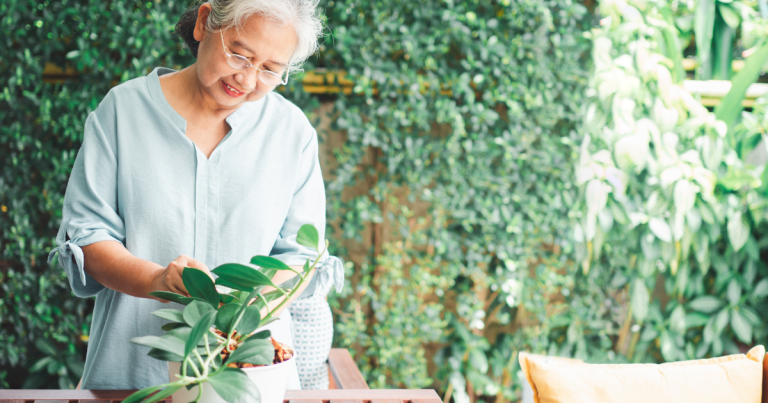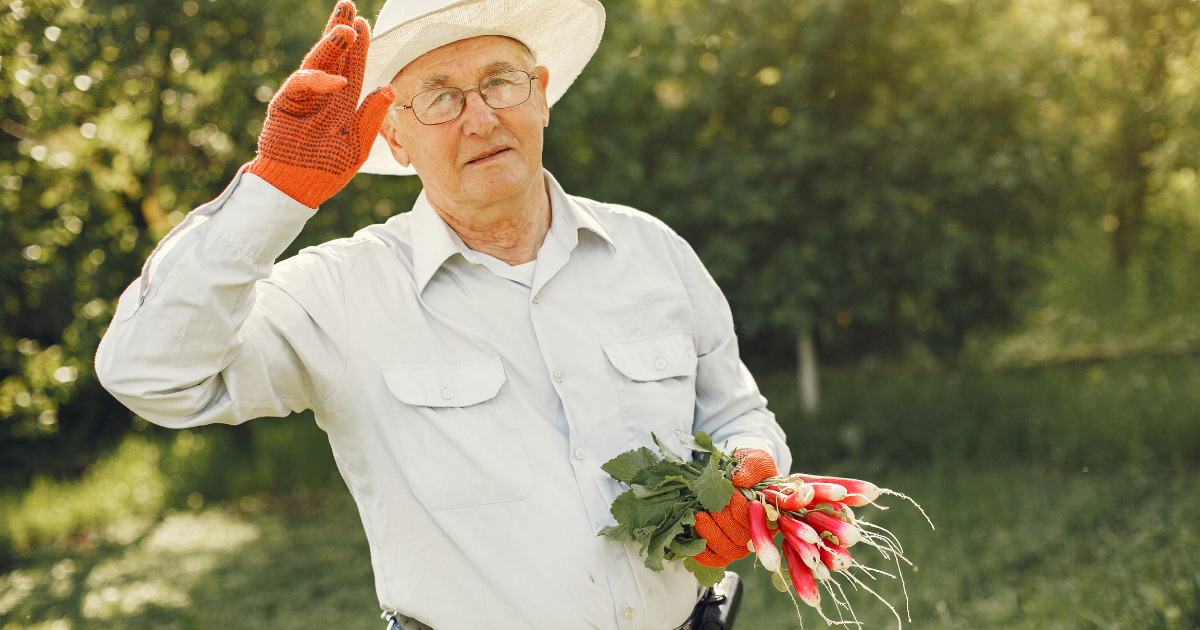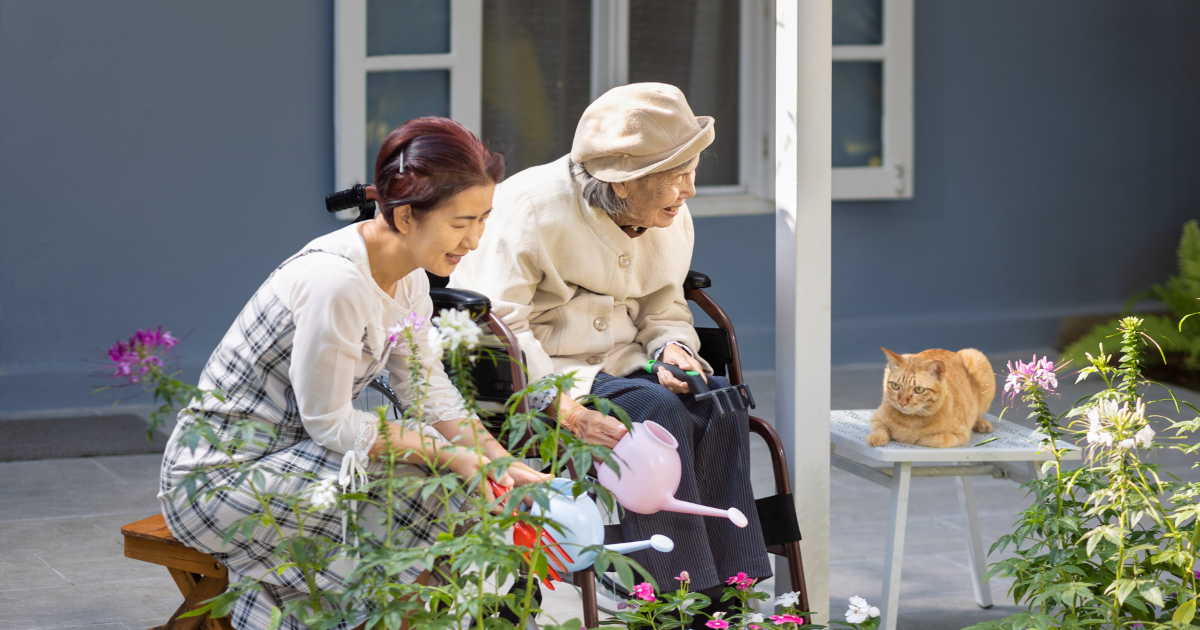
Gardening is one of life’s simple pleasures. It’s a way to stay active and enjoy the fresh air. For seniors, gardening offers so much more—mental clarity, stress relief, and even improved physical health.
A study published in The Lancet Planetary Health found that seniors who joined community gardening increased their weekly physical activity by around 40 minutes. This extra movement helps improve heart health, build stamina, and support healthy weight management—all important for staying fit and feeling good.
Gardening isn’t just good for your body; it’s great for your mind, too. Community gardens, for example, give seniors the chance to meet new people, share gardening tips, and work together on a project. This sense of connection and belonging can reduce feelings of loneliness and boost overall happiness, making gardening as rewarding socially as it is personally.
That said, some aspects of gardening, like bending, digging, or trimming plants, can get harder with age. Limited mobility, joint pain, or arthritis can make certain tasks seem more difficult. But here’s the good news: you don’t have to let these challenges stop you from enjoying your garden.
Using the right tools can make all the difference. Today’s gardening tools are designed to make tasks easier and more comfortable. Lightweight tools, long handles, and grips that are easy to hold can help you manage your garden with less effort. With the right setup, gardening can stay an enjoyable, stress-free part of your life for years to come.
Choosing the Right Tools for Senior Gardeners
 The first step to making gardening more accessible is selecting tools that work with you, not against you. The right garden tools can reduce the physical strain of gardening so you can enjoy this outdoor hobby. Tools made from lightweight materials, like aluminum or reinforced plastic, are not only easier to carry but also reduce fatigue during extended gardening sessions. These materials are strong enough to handle tough gardening tasks while being gentle on your hands and arms.
The first step to making gardening more accessible is selecting tools that work with you, not against you. The right garden tools can reduce the physical strain of gardening so you can enjoy this outdoor hobby. Tools made from lightweight materials, like aluminum or reinforced plastic, are not only easier to carry but also reduce fatigue during extended gardening sessions. These materials are strong enough to handle tough gardening tasks while being gentle on your hands and arms.
Ergonomics plays an equally important role. Ergonomic tools with handles designed to fit naturally in your hand can significantly reduce stress on your wrists and require less grip strength, making them ideal for seniors with arthritis or limited dexterity. This thoughtful design helps prevent discomfort and allows for a longer, more enjoyable time in the garden.
For those who love tending to their plants but struggle with bending or stretching, long-handled tools are a must-have. These tools bring your reach to where it’s needed, whether it’s trimming high branches or pulling weeds without crouching. They’re an effective way to protect your back and knees while staying productive in the garden.
Similarly, tools with padded, slip-resistant grips provide a stable and comfortable hold, even during repetitive tasks. These features are particularly helpful for individuals managing joint pain, as they reduce strain and improve overall control.
When choosing your gardening tools, think of them as an investment in your long-term comfort and ability to enjoy your garden for years to come. The right tool isn’t just a convenience—it’s the key to transforming challenging tasks into rewarding parts of your routine, helping you focus on what you love most about gardening.
Essential Gardening Tools for Seniors
Some tools are essential for creating a more comfortable gardening experience.
- Pruning shears. Look for lightweight models with spring-assisted mechanisms and easy-grip handles. They make trimming plants less taxing on your hands.
- Garden kneeler and foldable seats. These handy helpers reduce pressure on your knees and back, making it easier to work closer to the ground.
- Hand trowels and cultivators. When digging holes in the dirt, choose hand trowels and cultivators with ergonomic designs to keep your wrists and hands comfortable during use.
- Watering cans & hoses. Lightweight watering cans with balanced designs make pouring easier, while ergonomic hose attachments simplify the process for those with limited strength.
- Long-handled weeders and clippers. If your back and knees are problematic, look for long-handled weeders and clippers to help reduce the need to stoop or crouch. These are also helpful when dealing with taller plants, reducing the need to climb on a ladder or step stool.
Specialty Tools for Extra Support
If you have arthritis or limited mobility, there are tools designed specifically for you. Ratchet pruners, for instance, reduce the effort needed to cut through thick branches, while adjustable garden stools provide a comfortable resting spot during longer tasks.
Raised beds and self-watering planters are great solutions for bending down to the ground. These options let you tend to your plants at waist height and reduce the need for daily watering. For trimming or shearing, battery-powered tools can save you from the manual effort required with traditional equipment.
These specialty tools aren’t just about convenience—they’re about ensuring gardening remains a safe and enjoyable activity, no matter your physical limitations.
Tips for Safe and Enjoyable Gardening
 Gardening should be a source of joy and relaxation, not a cause of discomfort or fatigue. To keep it that way, it’s essential to take care of yourself while you tend to your plants. Start by pacing yourself. Garden tasks don’t have to be done all at once—break it into smaller tasks and take frequent breaks to rest and recharge. Overexertion can lead to unnecessary aches, so listening to your body is key.
Gardening should be a source of joy and relaxation, not a cause of discomfort or fatigue. To keep it that way, it’s essential to take care of yourself while you tend to your plants. Start by pacing yourself. Garden tasks don’t have to be done all at once—break it into smaller tasks and take frequent breaks to rest and recharge. Overexertion can lead to unnecessary aches, so listening to your body is key.
Staying hydrated is essential while gardening. Keep a water bottle close by and take regular sips, especially when working under the heat or in direct sun. Protecting yourself from the sun’s rays is equally important—wear a wide-brimmed hat and apply sunscreen to shield your skin from the harmful rays. To avoid overheating and heat stroke, choose lightweight, breathable clothing.
Organization is also a valuable tool in your gardening routine. Keeping your tools within easy reach—whether in a bucket, garden cart, or an apron with pockets—saves time and minimizes extra movement. This simple step can conserve energy and allow you to focus on your plants instead of searching for what you need.
Stretching before and after gardening is another small but impactful adjustment. Warming up your muscles with light stretches can help prevent stiffness, while a post-gardening stretch helps you recover and stay limber for the next day. Focus on your back, shoulders, and hands, which often do the most work.
Gardening is a beautiful way to stay active, connect with nature, and enjoy a sense of accomplishment. However, far too many seniors believe they must give up activities like gardening as they age. Fortunately, this is not true! If you incorporate these tips into your routine and choose tools that match your needs and comfort, you can continue to garden well into your retirement years.
Welcome to FellowshipLIFE
At FellowshipLIFE, we understand the importance of hobbies like gardening in maintaining a vibrant, fulfilling lifestyle. Our Life Plan Communities are designed to support your passions and help you thrive. In fact, we have a 72-acre scenic campus and a year-round greenhouse, so you can enjoy gardening no matter what season it is!
If you’re ready to learn more about how we can support your independence and well-being, contact us today. Let’s grow something wonderful together!




